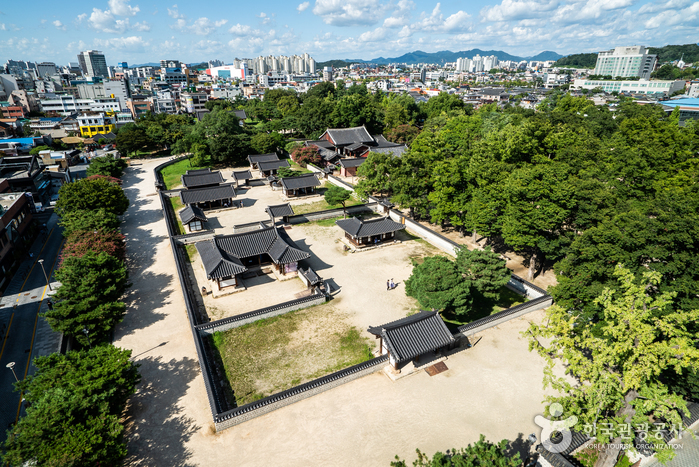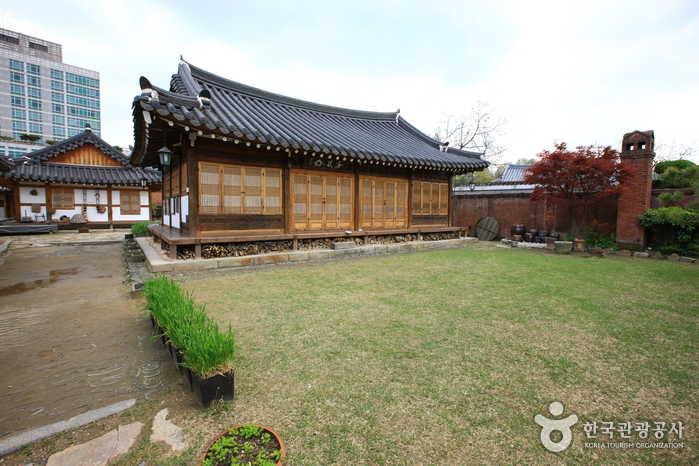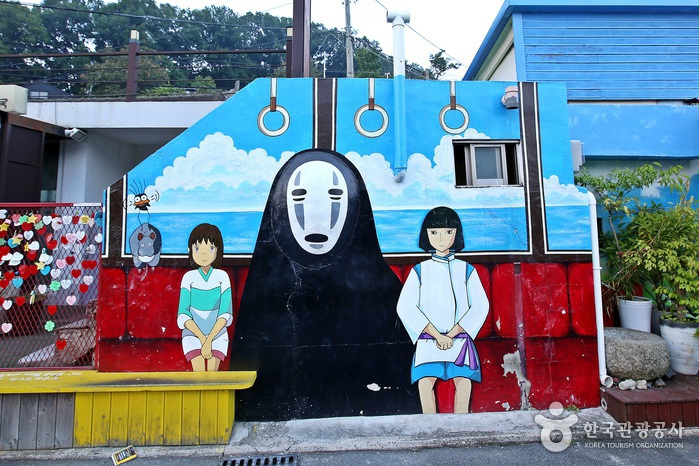Ilrakdang sarangchae [Korea Quality] / 일락당사랑채 [한국관광 품질인증]
296.0289988694322m 2872 2024-04-07
15, Choemyeonghui-gil, Wansan-gu, Jeonju-si, Jeonbuk-do
+82-10-3084-6679
A must visit place for tourists in Jeonju, Ilrakdang Sarangchae is located in the middle of the traditional Korean house village of Jeonju. The very first of three enjoyments for noble man, as indicated by Menicus, the existence of parents and brothers with no troubles is what the place is named after. Standing in the garden, you can easily see the stone walls of Gyeonggijeon and also you are within the range of walking distance to Jeondong catholic church, Omokdae, Southern market, Jeonju Hyanggyo, and the wall painting village of Jaman.
The rooms are called, Haengbokchae, Sarangbang, Mitum band, Monday, Tuesday, Wednesday, Thursday, Friday, Saturday, Sunday and so on. Haengbok room 1/2, a living room with furnace, a big sized attic above the living room are shared together, which makes it most suitable for big families or a small group of tourists. The Monday/Tuesday/Friday/Saturday/Sunday rooms all have a small, cozy attic and in every guest room’s wall, column and doors are mainly made of woods which makes them feel very warm. On every morning, in the shared kitchen, simple breakfasts mainly consisting of toasts, jams, coffee and juice are served. All guests are provided with discounts on Korean costume rental(30%), motor bikes(30%) and waengi bean sprout soup with rice (1000KRW). Besides, there are various services such as introduction to tasty restaurants in partnerships with traditional Korean house villages, as well as discounts, and try out of Korean rice cake making experiences and so on.
Jeonjuhyanggyo Local Confucian School (전주향교)
316.14426890938245m 30148 2024-05-28
139 Hyanggyo-gil, Wansan-gu, Jeonju-si, Jeonbuk-do
+82-63-288-4548
Jeonjuhyanggyo is a local Confucian school that was established during the Joseon dynasty (1392-1910) and is a designated Historic Treasure. This was a national education center during the Joseon period. The school was originally located at the Gyeonggijeon Shrine site, but was relocated in 1603. The mortuary tablets of seven Chinese Confucian scholars and 18 Korean scholars are enshrined in the main building of Daeseongjeon Hall.
Ihwa Gotaek [Korea Quality] / 이화고택 [한국관광 품질인증]
321.27204748330286m 12 2024-04-07
91 , Hanji-gil, Wansan-gu, Jeonju-si, Jeonbuk-do
+82-10-9668-6232
Ihwa Old House in Jeonju Hanok Village, Jeollabuk-do, is a charming hanok stay with a more than 100-year history, which preserves the traditional hanok pattern of connected wood-floored spaces called Numaru, Toenmaru and Jjongmaru. There are eight guestrooms, all equipped with a toilet. All new guests are welcomed with a glass of home-made sikhye (sweet rice drink) or patbingsu (shaved ice red bean desert), while for breakfast bibimbap or rice-cake soup will be served in Korean brass bowls. Guests can have a go at traditional crafts such as pansori, the tea ceremony, natural dyeing, and hanji making.
Gyeonggijeon Shrine (경기전)
340.142447434044m 55856 2024-05-27
44 Taejo-ro, Wansan-gu, Jeonju-si, Jeonbuk-do
+82-63-281-2790
A registered Historic Site, Gyeonggijeon Shrine was erected in 1410 and holds the portrait of King Tae-jo, the founder of the Joseon dynasty. The shrine was originally given the name Eoyongjeon, but was changed to its current name in 1442, the 24th year of King Sejong the Great. The structure was partially destroyed during the Imjin War (1592-1598), and was restored in 1614.
Jeonju Jeondong Catholic Cathedral (전주전동성당)
341.4752609092589m 52001 2024-05-27
51 Taejo-ro, Wansan-gu, Jeonju-si, Jeonbuk-do
Jeondong Catholic Cathedral in Jeonju was built in honor of Roman Catholic martyrs of the Joseon dynasty on the very same spot the martyrs lost their lives. The land was purchased by French Priest Baudenet in 1891 (28th year of King Gojong), but construction of the church did not begin until 1908. Construction was completed in 1914, a time during which Korea was under Japanese rule. Though originally built just outside of Pungnammun Gate, the site of the martyrs, the church was later moved to its current location for expansion.
The first Romanesque building in the Honam region, Jeondong Catholic Cathedral is made of gray and red bricks and bears a striking resemblance to the Myeongdong Cathedral in Seoul, also designed by Priest Poinel. Not only considered one of the most beautiful Catholic churches in Korea, some even go so far as to say it is one of the most beautiful structures in all of Korea, citing the church’s unique combination of Byzantine and Romanesque architectural styles. The rectangular building is topped with three Byzantine bell towers (to the right, center, and left) and boasts arched ceilings, several of which meet in the form of a cross.
It is interesting to note that some of the bricks used in construction of the church were made using materials from the Jeonjueupseong Walled Town, which was torn down by the Japanese. It is also said that the cornerstone of the church came from a wall of Jeonjueupseong Walled Town near Pungnammun Gate.
PoongNamheon [Korea Quality] / 풍남헌 [한국관광 품질인증]
369.32644187549045m 8160 2024-04-07
35 , Eunhaeng-ro, Wansan-gu, Jeonju-si, Jeonbuk-do
+82-63-286-7673, +82-10-2757-7673
Pungnamheon is a hanok stay in a traditional nobleman's house in Jeonju, Jeollabuk-do. Next to the house stands a 600-year-old ginkgo tree, the guardian spirit of Jeonju Hanok Village. Two unusual features of this hanok is that there is no wood-floored hall or daecheong, and the toenmaru wooden porch is extra wide, and has a window. The floors are finished with laquered hanji (Korean paper), and the roof tiles were made in Goryeong. Old folding screens and Korean paintings complete the atmosphere of a traditional yangbang house. Guests have a chance to taste wild green tea gathered and made by the owner.
Jeonggahanog [Korea Quality] / 정가한옥 [한국관광 품질인증]
369.71709082618224m 177 2024-04-07
78-3 , Girin-daero, Wansan-gu, Jeonju-si, Jeonbuk-do
+82-10-9934-1300, +82-10-3677-1928
Jeongga Hanok, standing right across the road from Jeonju Hanok Village, Jeollabuk-do, is a newbuild hanok combining traditional style with modern comfort. Guestrooms are cypress-walled and red clay-grounded. Thus the Cypress room has walls and ceilings of cypress wood. The Maple room and the Gingko room both have attics. Nearby tourist attractions, which can all be reached on foot, include Gyeonggijeon Hall, Jeondong Cathedral, Jeonju Hyanggyo Confucian School, Jaman Mural Village - and of course Jeonju Hanok Village.
Dongnagwon House (동락원)
370.45580402380193m 13096 2024-04-07
33-6, Eunhaeng-ro, Wansan-gu, Jeonju-si, Jeonbuk-do
+82-63-285-3490
The Dongnagwon House in Jeonju Hanok Village provides a getaway to experience hanok stay and traditional Korean life. Affiliated with Jeonju Kijeon College, Dongnagwon is also a memorial hall dedicated to W. M. Junkin, who came to Korea as a missionary from the South Presbyterian Church of the United States in 1892. Dongnagwon is a reproduction of the old hanok houses in Jeonju from the time when W. M. Junkin was doing his missionary work in the area. It is
comprised of three buildings: Anchae (main hall), Sarangchae (guest house), and Haengnangchae (servants’ quarters).
Visitors to Dongnagwon can learn and experience traditional Korean culture such as music, crafts, and dance while inhabiting traditional lodging. In addition to providing accommodation for individual guests, Dongnagwon is also used for group accommodations or activities such as seminars, conferences, and family events. For groups of 30 or more, it is possible to rent out the entire venue (in addition to all facilities, including Seungdokdang, Seunghwadang, Cheongyuje, and the front yard).
Jaman Mural Village (자만마을 벽화갤러리)
375.0839820907546m 1 2024-05-02
Gyo-dong, Wansan-gu, Jeonju-si, Jeonbuk-do
Jaman Mural Village is located on a hillside across the road from Jeonju Hanok Village. The village was formed by Korean war refugees resettling where they could, and remained as a small village interlaced by narrow pathways until 2012. At that point, the village was enlivened with over 40 murals and became popular for photographs. Many of the houses have been converted into cafes, guesthouses, and restaurants.
Jaman Mural Village (자만벽화마을)
376.0613477219141m 1664 2024-04-07
1-10, Jamandong 1-gil, Wansan-gu, Jeonju-si, Jeonbuk-do
Jaman Mural Village is located in the ridge between Omokdae and Imokdae along the foot of Seungamsan Mountain’s Jungbawi Rock. Jeonju Hanok Village is also visible from the wide street. Although it is a fairly steep walk up to Jaman Village, visitors will be able to enjoy colorful murals painted on the buildings and walls along the way.
![Ilrakdang sarangchae [Korea Quality] / 일락당사랑채 [한국관광 품질인증]](http://tong.visitkorea.or.kr/cms/resource/57/2596657_image2_1.jpg)

![Ihwa Gotaek [Korea Quality] / 이화고택 [한국관광 품질인증]](http://tong.visitkorea.or.kr/cms/resource/50/2707550_image2_1.jpg)


![PoongNamheon [Korea Quality] / 풍남헌 [한국관광 품질인증]](http://tong.visitkorea.or.kr/cms/resource/73/3022073_image2_1.jpg)
![Jeonggahanog [Korea Quality] / 정가한옥 [한국관광 품질인증]](http://tong.visitkorea.or.kr/cms/resource/62/2594362_image2_1.jpg)


 English
English
 한국어
한국어 日本語
日本語 中文(简体)
中文(简体) Deutsch
Deutsch Français
Français Español
Español Русский
Русский